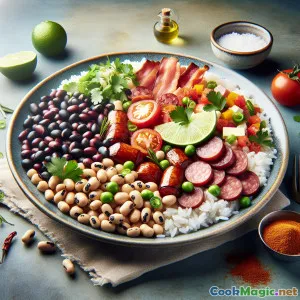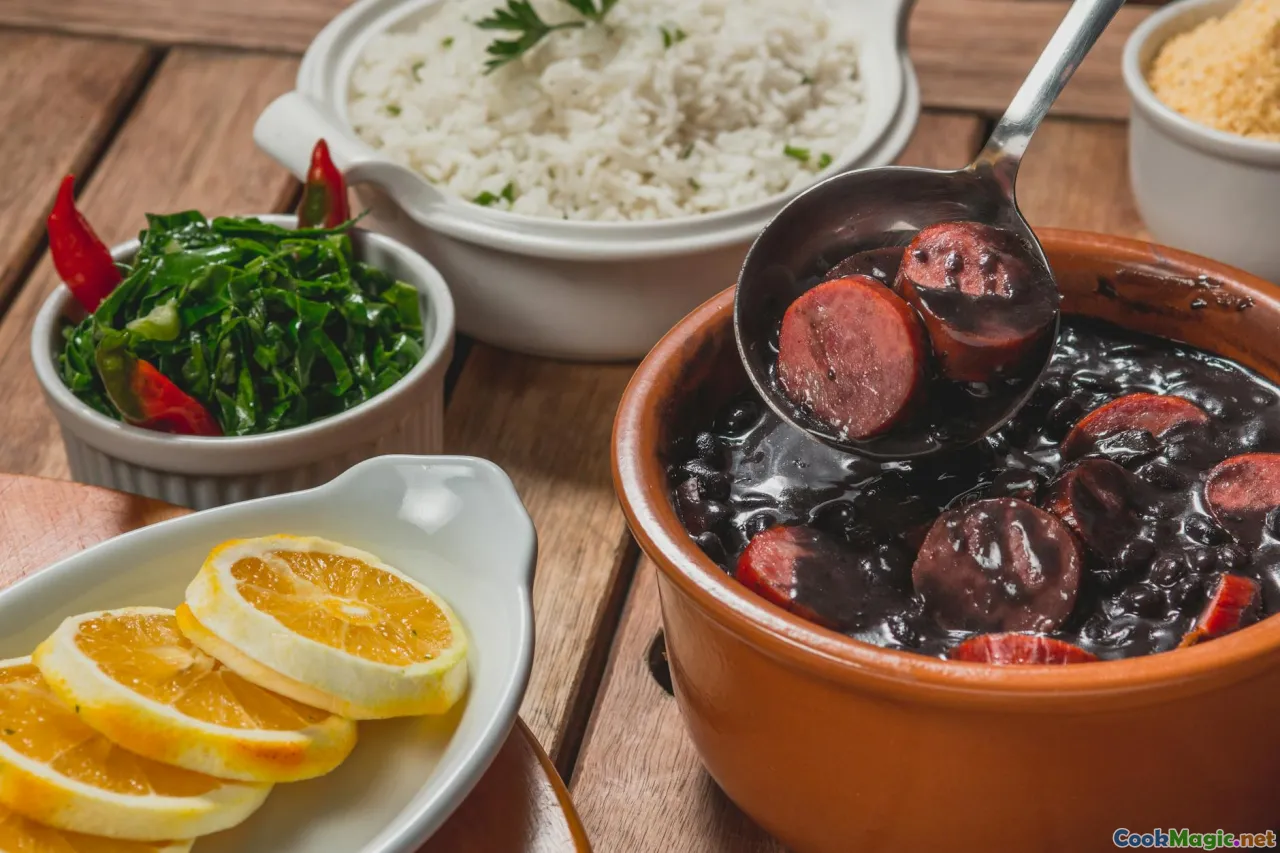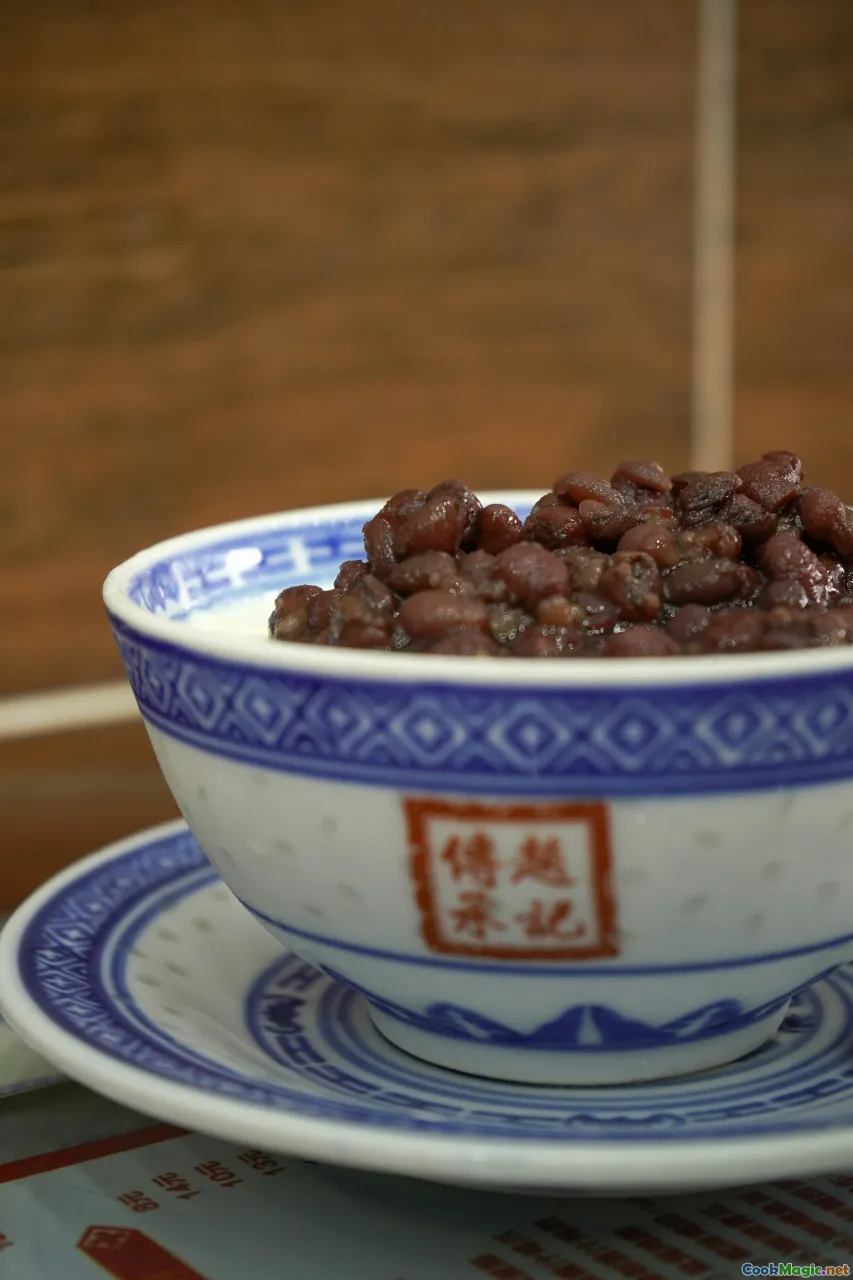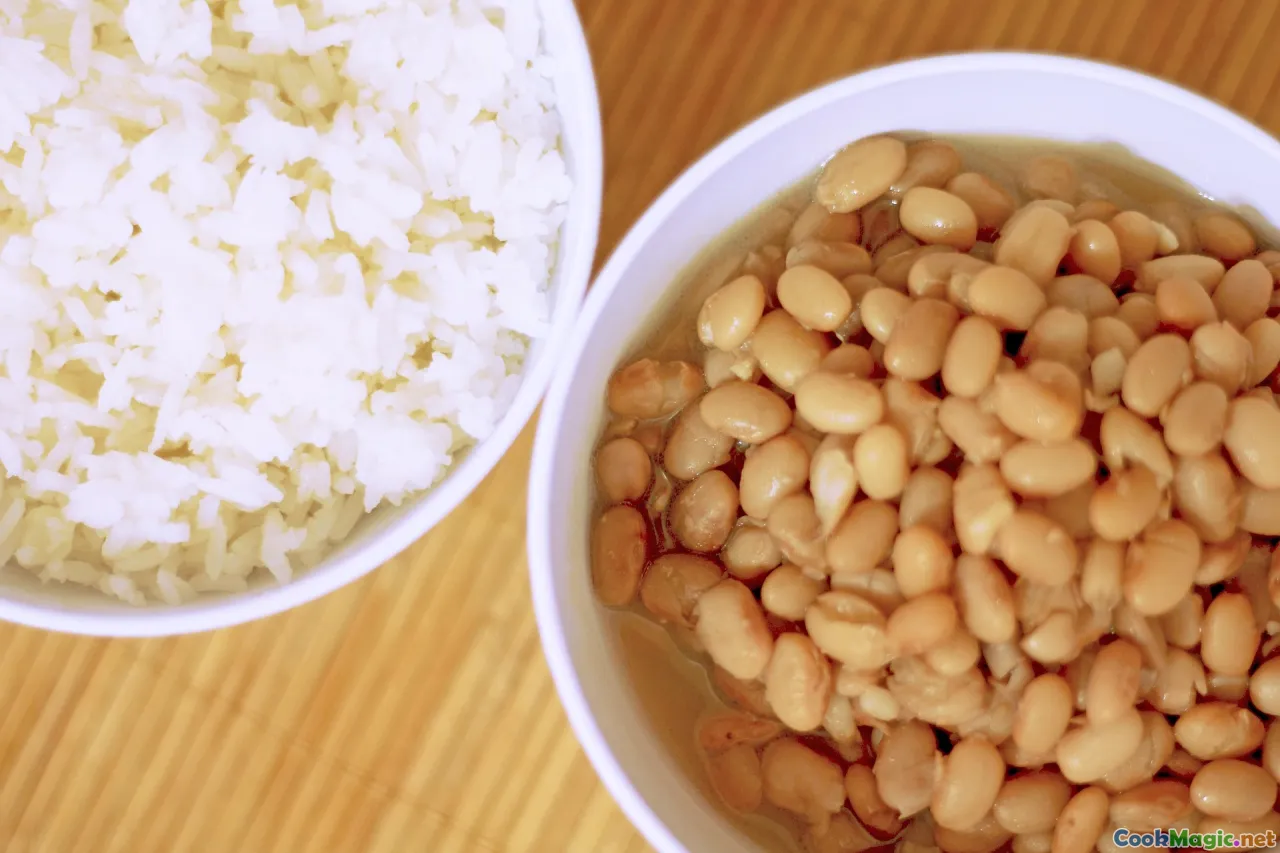
그릴에 구운 Coalho 치즈와 함께하는 북동부 브라질의 쌀과 콩
(Northeast Brazilian Rice and Beans with Grilled Coalho)
(0 리뷰)재료
-
250 grams 코드콩(카우피스) 또는 검은 눈콩
(Use canned (drained) to save time; if dried, pre-cook until just tender)
-
300 grams 장립백미
(Rinse briefly to remove excess starch, do not over-wash)
-
900 ml 닭육수 또는 소고기 육수
(Or use water with 1 tsp salt; warm before adding)
-
100 grams 다진 베이컨
(Smoked bacon adds depth; trim excess rind)
-
150 grams Calabresa(훈제 소시지), 얇게 썬
(Substitute chorizo or kielbasa)
-
200 grams Carne de sol (소금에 절인 소고기), 염분 제거 후 찢은
(Soak and simmer to remove excess salt; sub rehydrated jerked beef or omit)
-
150 grams 다진 노란 양파
(About 1 medium onion)
-
4 cloves 다진 마늘
(Fresh garlic preferred)
-
80 grams 청피망, 다진
(Adds subtle sweetness and color)
-
120 grams 토마토 (다진 것)
(Optional freshness; remove seeds for a drier pot)
-
1 leaf 월계수 잎
(Adds gentle herbal backbone)
-
0.5 tsp 갈은 커민
(Warm earthiness; use lightly)
-
1 tsp Colorau (annatto) 또는 달콤한 파프리카
(Traditional color and aroma)
-
1.5 tsp 소금
(Adjust to taste depending on stock and meats)
-
0.5 tsp 흑후추
(신선하게 갈아서, 맛에 따라)
-
250 grams Queijo coalho, 바톤 모양으로 자른 치즈
(Sub halloumi or firm paneer if unavailable)
-
1 tbsp 무염 버터 또는 manteiga de garrafa
(For gloss and regional flavor)
-
2 tbsp 얇게 썬 대파
(Reserve some for garnish)
-
2 tbsp 신선한 고수 (다진)
(Essential Northeastern touch)
-
30 grams 구운 카사바 가루
(For crunchy finishing sprinkle (farofa style))
-
1 piece 라임
(서빙을 위해 조각으로 자르세요)
-
1 tbsp 식물성 기름
(For searing meats and grilling cheese)
(Use canned (drained) to save time; if dried, pre-cook until just tender)
(Rinse briefly to remove excess starch, do not over-wash)
(Or use water with 1 tsp salt; warm before adding)
(Smoked bacon adds depth; trim excess rind)
(Substitute chorizo or kielbasa)
(Soak and simmer to remove excess salt; sub rehydrated jerked beef or omit)
(About 1 medium onion)
(Fresh garlic preferred)
(Adds subtle sweetness and color)
(Optional freshness; remove seeds for a drier pot)
(Adds gentle herbal backbone)
(Warm earthiness; use lightly)
(Traditional color and aroma)
(Adjust to taste depending on stock and meats)
(신선하게 갈아서, 맛에 따라)
(Sub halloumi or firm paneer if unavailable)
(For gloss and regional flavor)
(Reserve some for garnish)
(Essential Northeastern touch)
(For crunchy finishing sprinkle (farofa style))
(서빙을 위해 조각으로 자르세요)
(For searing meats and grilling cheese)
영양 정보
- 인분: 4
- 1인분 크기: 1접시 (300g)
- Calories: 680 kcal
- Carbohydrates: 0 g
- Protein: 34 g
- Fat: 28 g
- Fiber: 10 g
- Sugar: 4 g
- Sodium: 950 mg
- Cholesterol: 70 mg
- Calcium: 350 mg
- Iron: 5 mg
조리법
-
1 - Rinse and prep beans:
If using dried cowpeas, rinse and quick-soak in hot water for 10 minutes. Drain. If using canned, simply drain and rinse.
-
2 - Pre-cook beans:
Cover dried beans with fresh water and simmer until just tender but holding shape (about 25–30 minutes). Drain and set aside. Skip if using canned.
-
3 - Render bacon and brown meats:
Heat oil in a wide pot. Add bacon and cook until crisp and its fat renders. Add calabresa and carne de sol, browning lightly. Transfer meats to a plate, leaving fat in pot.
-
4 - Sauté Aromatics:
In the same pot, add onion and bell pepper; cook until softened. Stir in garlic for 30 seconds until fragrant.
-
5 - Toast rice and bloom spices:
Add rinsed rice, stirring to coat in fat. Sprinkle colorau, cumin, bay leaf, salt, and pepper. Toast 1–2 minutes until grains look slightly translucent.
-
6 - Combine with beans and stock:
Return browned meats to the pot. Fold in the pre-cooked beans and tomato. Pour in warm stock and bring to a lively simmer.
-
7 - Simmer Gently:
Reduce heat to low, cover, and cook until rice is tender and liquid absorbed (15–18 minutes). Avoid stirring to keep grains intact.
-
8 - Grill queijo coalho:
While the rice rests, heat a skillet or grill. Sear queijo coalho batons in a thin film of oil until well charred on all sides.
-
9 - Finish with herbs and butter:
Fluff the baião with a fork. Stir in butter, scallions, and cilantro. Adjust salt and pepper to taste.
-
10 - Top and Serve:
Nestle or scatter grilled queijo coalho over the rice and beans. Sprinkle with toasted cassava flour and serve with lime wedges.
If using dried cowpeas, rinse and quick-soak in hot water for 10 minutes. Drain. If using canned, simply drain and rinse.
Cover dried beans with fresh water and simmer until just tender but holding shape (about 25–30 minutes). Drain and set aside. Skip if using canned.
Heat oil in a wide pot. Add bacon and cook until crisp and its fat renders. Add calabresa and carne de sol, browning lightly. Transfer meats to a plate, leaving fat in pot.
In the same pot, add onion and bell pepper; cook until softened. Stir in garlic for 30 seconds until fragrant.
Add rinsed rice, stirring to coat in fat. Sprinkle colorau, cumin, bay leaf, salt, and pepper. Toast 1–2 minutes until grains look slightly translucent.
Return browned meats to the pot. Fold in the pre-cooked beans and tomato. Pour in warm stock and bring to a lively simmer.
Reduce heat to low, cover, and cook until rice is tender and liquid absorbed (15–18 minutes). Avoid stirring to keep grains intact.
While the rice rests, heat a skillet or grill. Sear queijo coalho batons in a thin film of oil until well charred on all sides.
Fluff the baião with a fork. Stir in butter, scallions, and cilantro. Adjust salt and pepper to taste.
Nestle or scatter grilled queijo coalho over the rice and beans. Sprinkle with toasted cassava flour and serve with lime wedges.
그릴에 구운 Coalho 치즈와 함께하는 북동부 브라질의 쌀과 콩 :에 대한 자세한 정보
What makes Baião de Dois com Queijo Coalho special
Baião de Dois is one of Northeastern Brazil’s most beloved comfort dishes, a hearty marriage of rice and beans that is both rustic and celebratory. The name nods to “baião,” a vibrant musical rhythm from the Sertão popularized by Luiz Gonzaga—think of the plate as culinary choreography: rice and beans step in synchrony while smoky meats and squeaky, charred queijo coalho improvise on top. In this version, the gentle nuttiness of cowpeas (feijão-de-corda) or black-eyed peas meets fluffy long-grain rice, perfumed with annatto (colorau), garlic, onion, and a whisper of cumin. Crisp bacon and smoky sausage provide a savory backbone, while grilled queijo coalho adds a salty, caramelized snap that keeps you diving back in for more.
Ingredients, swaps, and sourcing
- Beans: Cowpeas are traditional in Ceará and Piauí, but black-eyed peas are a widely available stand-in. If you’re pressed for time, canned beans work perfectly—just drain and rinse to reduce excess starch and sodium.
- Rice: Choose a long-grain variety that cooks up loose and fluffy. Basmati can work in a pinch, but standard long-grain white rice is closest to Brazilian texture.
- Meats: Calabresa and carne de sol bring smoke and umami. If you can’t find them, try chorizo/kielbasa and rehydrated beef jerky. For a vegetarian version, omit the meats and lean on smoked paprika, roasted peppers, and a dash of liquid smoke.
- Cheese: Queijo coalho is a grillable, brined cheese that chars without melting—halloumi is the best global substitute, with firm paneer as a milder option.
- Colorau: Annatto’s earthy aroma and sunset hue are classic. Sweet paprika delivers color if annatto is unavailable.
Technique tips for success
- Bean texture first: Pre-cook dried beans just to tender, not creamy. Overcooked beans can break and muddy the rice. If using canned, add gently to avoid crushing.
- Toast the rice: A brief toasting in rendered fat helps separate grains and builds a nutty base, ensuring the one-pot doesn’t turn gluey.
- Gentle simmer, lid on: Keep heat low and resist stirring once the liquid is added. A tight lid lets rice steam evenly while absorbing the flavors of stock, meats, and aromatics.
- Char the cheese: A well-heated skillet or grill pan yields the signature blistered stripes on queijo coalho. A light film of oil prevents sticking and promotes even browning.
- Rest time matters: Five minutes off heat lets steam redistribute, giving you fluffy grains and a cohesive, spoonable texture.
Make-ahead, storage, and safety
- Make-ahead: Cook beans up to 3 days in advance and refrigerate in their cooking liquid. You can also assemble the rice-and-beans base a day ahead; reheat gently with a splash of stock.
- Storage: Refrigerate leftovers within 2 hours in shallow containers. They’ll keep 3–4 days. Reheat covered with a little water or stock to revive moisture.
- Freezing: The rice-and-beans component freezes well for up to 2 months; add freshly grilled cheese after reheating for the best texture.
Serving ideas and pairings
- Garnishes: A sprinkle of toasted cassava flour (farofa) adds crunch, while cilantro and scallions lift the richness. Lime wedges offer brightness.
- Complements: Serve with vinagrete (Brazilian tomato-onion vinaigrette), sautéed collards, or fried plantains. A sunny-side egg turns it into a hearty brunch.
- Drinks: A classic caipirinha, cachaça neat, or a crisp pilsner pairs beautifully. For non-alcoholic options, try lime soda or iced mate.
Cultural notes and history
Baião de Dois springs from the resourcefulness of the Sertão, where cooks transformed pantry staples—rice, beans, preserved meats—into a dish that nourishes both body and soul. The “de dois” literally refers to the duo of rice and beans cooked together, and by extension to the duet-like interplay heard in baião music. As the dish traveled from farm kitchens to city restaurants, it evolved: some versions include only beans, rice, and herbs; others embrace sausage, bacon, or even cubes of pumpkin. Queijo coalho, native to the Northeast, is a natural partner—its firm, grillable texture stands up to the pot’s moisture while giving a playful squeak and satisfying char.
Variations to try
- Northeastern market style: Skip tomatoes and keep it drier and more aromatic, emphasizing cilantro, scallions, and colorau.
- Creamier comfort: Stir in a spoon of requeijão cremoso (Brazilian cream cheese) for a lush finish—less traditional, very cozy.
- Vegetarian baião: Replace meats with smoked mushrooms and roasted red peppers; use vegetable stock and add a dash of soy for depth.
- Spicy kick: Fold in malagueta chili or a spoon of chili oil for heat.
Final thoughts
Baião de Dois com Queijo Coalho embodies the warmth of Brazilian hospitality: unfussy, abundant, and irresistibly rhythmic. With a handful of accessible substitutions, you can bring the Northeast’s sun-soaked spirit to your table anywhere in the world. Focus on balance—loose grains, intact beans, smoky undertones, and that charred, bouncy cheese—and your baião will sing like a forró band on a summer night.























